Related Research Articles

Magnolia is a large genus of about 210 to 340 flowering plant species in the subfamily Magnolioideae of the family Magnoliaceae. It is named after the French botanist Pierre Magnol.

Moles are small mammals adapted to a subterranean lifestyle. They have cylindrical bodies, velvety fur, very small, inconspicuous eyes and ears, reduced hindlimbs, and short, powerful forelimbs with large paws adapted for digging.

Fragaria is a genus of flowering plants in the rose family, Rosaceae, commonly known as strawberries for their edible fruits. There are more than 20 described species and many hybrids and cultivars. The most common strawberries grown commercially are cultivars of the garden strawberry, a hybrid known as Fragaria × ananassa. Strawberries have a taste that varies by cultivar, and ranges from quite sweet to rather tart. Strawberries are an important commercial fruit crop, widely grown in all temperate regions of the world.

Dendrobium is a genus of mostly epiphytic and lithophytic orchids in the family Orchidaceae. It is a very large genus, containing more than 1,800 species that are found in diverse habitats throughout much of south, east and southeast Asia, including China, Japan, India, the Philippines, Indonesia, Australia, New Guinea, Vietnam and many of the islands of the Pacific. Orchids in this genus have roots that creep over the surface of trees or rocks, rarely having their roots in soil. Up to six leaves develop in a tuft at the tip of a shoot and from one to a large number of flowers are arranged along an unbranched flowering stem. Several attempts have been made to separate Dendrobium into smaller genera, but most have not been accepted by the World Checklist of Selected Plant Families.
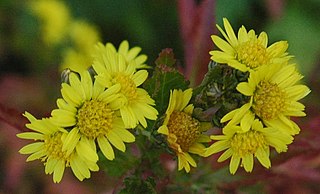
Chrysanthemums, sometimes called mums or chrysanths, are flowering plants of the genus Chrysanthemum in the family Asteraceae. They are native to East Asia and northeastern Europe. Most species originate from East Asia and the center of diversity is in China. Countless horticultural varieties and cultivars exist.
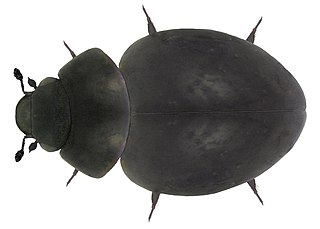
Sphaerius is a genus of beetles in the family Sphaeriusidae, comprising 18 species. It is one of the two extant genera in the family, the other being Bezesporum. They are typically found along the edges of streams and rivers, where they feed on algae; they occur on all continents except Antarctica. Three species occur in the United States.

Ginseng is the root of plants in the genus Panax, such as Korean ginseng, South China ginseng, and American ginseng, characterized by the presence of ginsenosides and gintonin. Ginseng is common in the cuisines and medicines of China and Korea.

The water caltrop is any of three extant species of the genus Trapa: Trapa natans, Trapa bicornis and the endangered Trapa rossica. It is also known as buffalo nut, bat nut, devil pod, ling nut, mustache nut, singhara nut or water chestnut.

Peter Hamilton Raven is an American botanist and environmentalist, notable as the longtime director, now President Emeritus, of the Missouri Botanical Garden.

Daphniphyllum is the sole genus in the flowering plant family Daphniphyllaceae and was described as a genus in 1826. The genus includes evergreen shrubs and trees mainly native to east and southeast Asia, but also found in the Indian Subcontinent and New Guinea.

Linnaea is a plant genus in the honeysuckle family Caprifoliaceae. Until 2013, the genus included a single species, Linnaea borealis. In 2013, on the basis of molecular phylogenetic evidence, the genus was expanded to include species formerly placed in Abelia, Diabelia, Dipelta, Kolkwitzia and Vesalea. However, this is rejected by the majority of subsequent scientific literature and flora.

Pharus, the stalkgrasses, is a genus of Neotropical plants in the grass family.
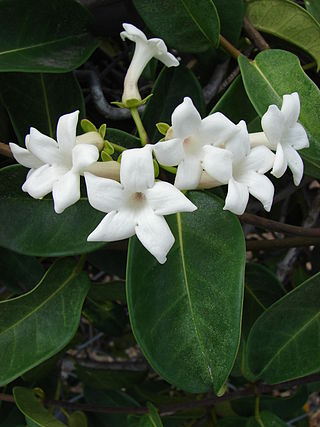
Marsdenia is a genus of plants in the family Apocynaceae first described as a genus in 1810. It is named in honor of the plant collector and Secretary of the Admiralty, William Marsden. The plants are native to tropical regions in Asia, Africa, Australia, and the Americas.

I. M. Johnston, was a United States botanist. He studied at Pomona College in Claremont, California and at Harvard University. His plant collections are housed in the Rancho Santa Ana Botanic Garden, in Claremont, and also in the Gray Herbarium of Harvard University.
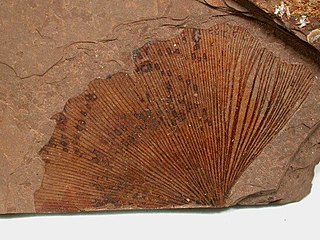
Ginkgo is a genus of non-flowering seed plants. The scientific name is also used as the English name. The order to which it belongs, Ginkgoales, first appeared in the Permian, 270 million years ago, and Ginkgo is now the only living genus within the order. The rate of evolution within the genus has been slow, and almost all its species had become extinct by the end of the Pliocene. The sole surviving species, Ginkgo biloba is only found in the wild in China, but is cultivated around the world. The relationships between ginkgos and other groups of plants are not fully resolved.

Melichrus is a genus of flowering plants in the family Ericaceae. The genus is endemic to Australia.
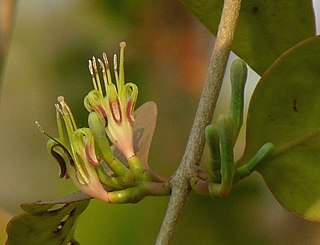
Macrosolen is a genus of plants in the family Loranthaceae. It includes about 83 species all over the world with ca. 40 species widely distributed in tropical South and Southeast Asia. Some species were described by de Loureiro, Lecomte, Danser (1938) and Hô (2003).

Sticherus tener, also known as silky fan-fern, is a common native ground-fern in the family Gleicheniaceae. It occurs growing along watercourses and drainage lines in rainforest that are dominated by Nothofagus cunninghamii. In Australia, it occurs in the states of Tasmania and Victoria. In New Zealand, it is known from two disjoint regions on the South Island. Like in other members of this genus, Sticherus tener have bright green fronds with repeatedly forking branches, branches bearing linear-shaped segments at almost right angles to the axis and form umbrella-like bush colony.
Lepistemon is a genus of flowering plants belonging to the family Convolvulaceae.